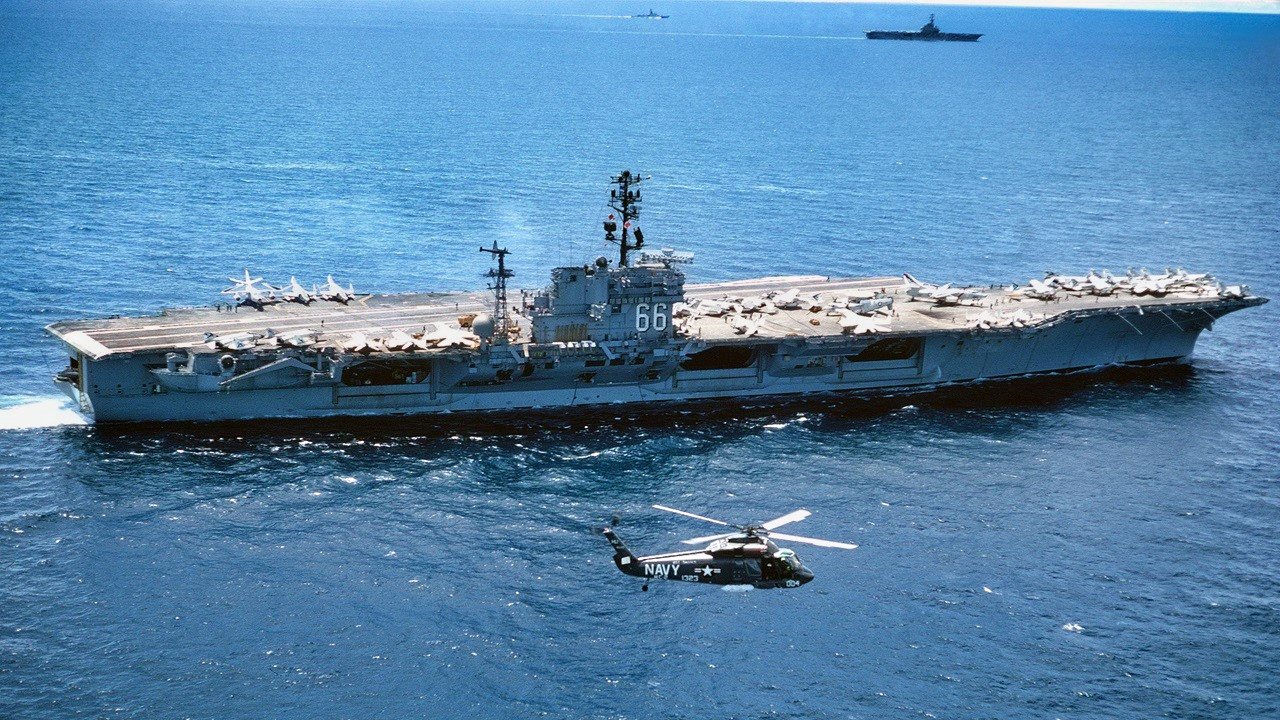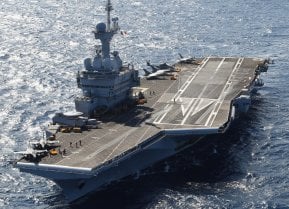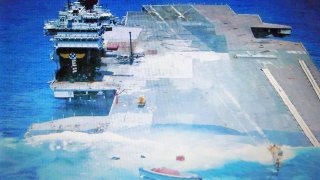USS America: The Navy Failed to Sink Its Own Aircraft Carrier
Initially, the America was scheduled to be scrapped for parts. That didn’t happen. Instead, USS America was selected for a live-fire test – a test that would result in her sinking.
At 11:30 am on May 14, 2005, the aircraft carrier USS America slipped beneath the waves and sank, for nearly three miles, before coming to rest upright, in one piece, upon the Atlantic floor.

For the veterans who served on the America viewed the sinking as a solemn moment. But the previous crews could take pride in the America’s exit: she had been intentionally scuttled, in an experiment to gauge how carriers respond to enemy attacks, gleaning invaluable defensive data in her sacrifice.
The USS America (CV-66) was one of three Kitty Hawk-class carriers built in the 1960s.
The Kitty Hawk-class of carriers was seen as an incremental improvement from the preceding Forrestal-class; the Kitty Hawks were a transitional batch of carriers. The America, nicknamed “The Big A,” was commissioned in 1965 and served until 1996.
Building the USS America of the Kitty Hawk-Class
When first ordered, America was planned to house a nuclear power plant. Yet, rising costs resulted in an alteration, mid-construction; the America would be conventionally powered, with four steam turbines producing 280,000 horsepower. The finished America measured 1,048 feet long with a 248-foot beam. The massive ship could reach 34 knots. Over 4,600 men were required to operate the carrier and her roughly 80 airplanes.
The Career of the USS America
America spent the majority of her career sailing the Atlantic and Mediterranean, although she was deployed to the Pacific on three occasions – all in support of the Vietnam War. The three decades for which the America served were relatively action-packed; the America loitered nearby, or participated directly, in several conflicts, including the Six-Day War, the Vietnam War, Operation El Dorado Canyon, and Operation Desert Storm. By the 1990s, more advanced, nuclear-powered carriers had long since become the norm; America was growing obsolete. Still, the U.S. Navy felt America had some more to contribute and she was scheduled to undergo a Service Life Extension Program (SLEP), which would push her service life out until 2010. However, budget cuts forced the America into retirement. America was decommissioned in a ceremony at Norfolk Naval Shipyard in 1996 before being transferred to the Inactive Ship Maintenance Facility in Philadelphia, Pennsylvania. And that’s when things got really interesting.
Life-Fire Tests Give America a Noble End
Initially, the America was scheduled to be scrapped for parts. That didn’t happen. Instead, America was selected for a live-fire test – a test that would result in her sinking. Navy veterans who had served on the America protested: you can’t sink a ship named after the U.S.A.! The Navy disagreed. Make the ship in a museum, the veterans pleaded. The Navy stood firm. The then-Vice Chief of Naval Operations, Admiral John B. Nathman, wrote a letter to America’s veterans, explaining the decision.
“America will make one final and vital contribution to our national defense, this time as a live-fire test and evaluation platform. America’s legacy will serve as a footprint in the design of future carriers – ships that will protect the sons, daughters, grandchildren, and great grandchildren of America veterans. We will conduct a variety of comprehensive tests above and below the waterline collecting data for use by naval architects and engineers in creating the nation’s future carrier fleet. It is essential we make those ships as highly survivable as possible. When that mission is complete, the America will slip quietly beneath the sea. I know America has a very special place in your hearts, not only for the name, but also for your service aboard her. I ask that you understand why we selected this ship for this one last crucial mission and make note of the critical nature of her final service,” Adm. Nathman wrote. The decision was final.
On February 25, 2005, a funeral-like ceremony was held in Philadelphia to salute America and her crew. With the goodbyes concluded, America sailed for the open ocean. On April 19, the live-fire tests commenced. The America proved to be a rather tough ship. For four weeks, the Navy punished America. Still, she wouldn’t sink. To scuttle America, she actually had to be boarded.
“It took four weeks and they ended up having to scuttle her from on board due to her not sinking,” mechanical engineer Blake Horner is quoted in theaviationgeekclub.com. “She is not only far larger than WWII battleships, but she is also a lot tougher. While she does not have the heavy armor battleships of yore had, she does have a double layered hull, meaning weapons have to push through alternative layers of steel and empty pockets to reach her internals. On top of that, her internal compartmentalization was far better than that of battleships. She is so large, there are so many more rooms that must be filled in order to make her sink than that of a battleship.”

When the America finally did slip beneath the waves, at approximately 11:30am EST, the Navy held a solemn moment of silence. America drifted downward for miles, finally coming to rest in one piece 16,860 feet below the surface, somewhere southeast of Cape Hatteras, North Carolina.
About the Author
Harrison Kass is a prolific defense writer with over 1,000 articles published. An attorney, pilot, guitarist, and minor pro hockey player, he joined the US Air Force as a Pilot Trainee but was medically discharged. Harrison has degrees from Lake Forest College, the University of Oregon, and New York University. He lives in Oregon and listens to Dokken. Follow him on Twitter @harrison_kass.
All images are Creative Commons.


